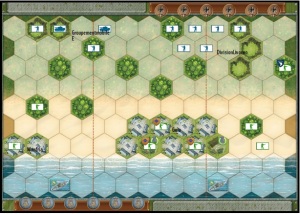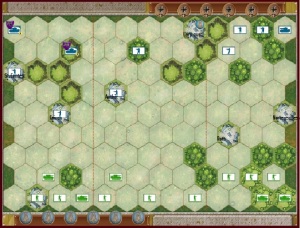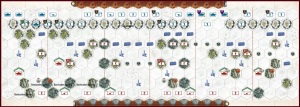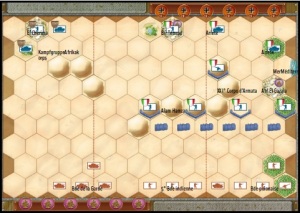Battle of Gela is an Operation Husky scenario for Memoir 44 by jdrommel which focuses on the early stages of the landings in Sicily. It’s an unusual map because it features an Axis force attacking an Allied force which has already occupied the beaches. The setup gives the Italian forces a chance, but as in reality, the balance was distinctly in the favor of the Allies.
On the 10th of July 1943, during operation Husky (Allied landing in Sicily), the harbour of Gela was captured by US Rangers units while the 1st US Infantry Division (the Big Red One) landed on the beaches around the city. Axis reacted quickly and Italian general Guzzoni sent at once troops against the US beach head. At 09h00, the Italian Mobile Group “E”, equipped with French R-35 tanks, made a counter-attack against landed troops,followed by infantrymen of the “Livorno” division. The Italian attack was a menace for the US supplies depots created on the landing beaches and in the harbour. The battle was fierce all the day and ended in a street fighting where US Rangers destroyed several Italian tanks with bazookas and grenades. In the same time the fire of the US Navy inflicted heavy losses to the Italian troops in the open ground. The counter-attack failed, Italian troops withdrew. Gela stayed in US Rangers hands.
The stage is set, the battle lines are drawn, and you are in command. The rest is history.
Here’s a screenshot of the map.
Note the Rangers holed up in Gela at the bottom, guarding two Axis victory medals. I think this might be the first time I’ve seen the Italian victory medal placed in an offensive location.
The biggest tactical decision the Allied player will make is, “What do I do with the Rangers?” The Axis player cannot win without killing one of them, or taking one victory medal, giving the Allied player the option of holding out on the defensive up to the very end. This can work because of the two destroyers patrolling off the coast. This gives them long-term firepower superiority which the Axis simply cannot match.
With a strong opening hand, the Axis can make a credible bid to win this battle. They have the infantry to push forward into the town of Gela, and their two armor units keep the Allies from feeling too confident about charging out of cover. However, unless things move quickly in their direction, the Axis player is going to start feeling the pain of constant long-range bombardment. If the Axis do make a push into Gela town, it will be quickly decisive in one direction or the other. On the other hand, a lucky Barrage by the Axis player in the early turns might knock out a ship, changing the balance of the game entirely.
This is an interesting battle because of how rare it is for the offensive player on a beach map to start on the inland side. However, from our playtests, it seems like even an excellent Axis opening can only ensure that the battle will be close. For our first game, my regular opponent (as Axis) opened with two Move Outs and two Infantry Assaults, while I was stuck with a hand full of center cards. He quickly gained five medals, but found it incredibly difficult to finish me off for the final medal. The battle quickly turned stupid, as I advanced a Ranger unit into the open to attack his tanks … and killed them both. His backfield infantry, most of which had used Italian super-retreat to get off the beaches after his initial success, finally won the game. For our second game, as Axis, I had nothing but probes, and felt lucky to end the battle with three medals.
Overall Evaluation – 3/5 – This is not a bad map, but the fact is that being inevitably destroyed by artillery just isn’t all that fun, and the novelty value wears off quickly.
Balance Evaluation – Allied Favored – DoW Online rates this as 61/39 Axis favored, but fully a third of those games were jdrommel playing himself, and another third were using a mysterious variant on Vassal. Sure, the Allies can give this away by pushing forward with their Rangers, but why?
First Turn Win Possibility – None – This scenario will be decided late, not early.
Plink-Fest Danger – Moderate – So long as the Axis tanks are intact, the Allied player should keep his units back in cover. However, an overly cautious Axis player will be mauled by naval fire, conceding the battle before it really gets started.



